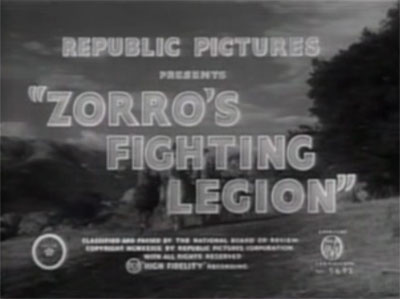
Republic, 12 Chapters, 1939. Starring Reed Hadley, William Corson, Sheila Darcy, Leander De Cordova, John Merton, Edmund Cobb, C. Montague Shaw, Jim Pierce, Budd Buster.
Our story opens in Mexico during the 1820s, where a successful revolution has just established an independent republic. Benito Juarez (Carleton Young), first president of the new nation, visits the ruling council of the province of San Mendolito to explain that that the fate of the country depends on them: their province contains the richest gold mines in Mexico, and a steady flow of gold is needed to help Juarez’s government put the country on its feet and establish its foreign credit. However, an evil figure has appeared to threaten Mexico’s security–an ancient Yaqui Indian idol named Don-Del-Oro that has suddenly come alive. Don-Del-Oro incites the Yaquis to make war against on the government’s gold trains, promising them that they shall again “live on the lands of their fathers.” Don-Del-Oro’s actual goal is to cripple the country’s finances, then use the Indians to overthrow the weakened republic and make himself Emperor. The villain is secretly one of four conspirators on the provincial council, all of whom are parties to the scheme: governor Felipe (Leander De Cordova), military commandant Manuel (John Merton), chief justice Pablo (C. Montague Shaw), and mining superintendent Gonzalez (Edmund Cobb). The evil quartet’s plans are threatened when fellow council-member Don Francisco (Guy D’Ennery) decides to organize a legion of caballeros to help protect the gold shipments; the villains manage to have Francisco killed, but the mysterious masked Zorro shows up to avenge him and take charge of the legion. Zorro, we soon learn, is actually Francisco’s nephew Don Diego Vega (Reed Hadley), who poses as a fop to lull the councilors’ suspicions. Although the conspirators manage to have Zorro’s Fighting Legion officially proscribed as bandits, our hero and his followers still manage to pacify the Indians, protect the gold shipments, and unmask the “Golden God” and his partners in treason.
Zorro’s Fighting Legion is not only one of Republic’s best-remembered Golden Age serials but one of their most distinctive as well: the cliffhanger’s setting–neither contemporary nor traditionally “Western”–gives the production a unique look and also challenges the writers and directors to come up with some novel variations on the studio’s standard action scenes. The resulting chapterplay is so impressive overall that it easily ranks as one of Republic’s cliffhanger masterpieces, despite some incidental flaws.
Writers Ronald Davidson, Barney Sarecky, Sol Shor, Franklin Adreon, and Morgan Cox are intelligent in their approach to the Zorro character, giving Diego a logical reason to assume his unheroic pose and making sure he keeps up a pretense of timidity throughout; far too many serial heroes not only have little motivation for their double masquerade but also behave identically whether masked or unmasked. The writers are less adept in their handling of the mystery villain; having the culprit be one of several known villains definitely diminishes the audience’s interest in guessing the guilty (in this case, the guiltiest) party.
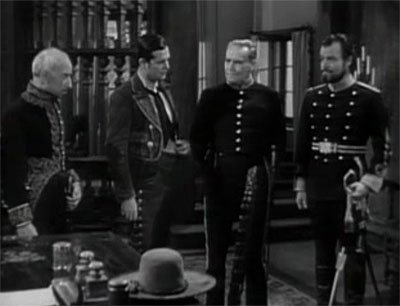
Above, from left to right: Villainous suspects Leander De Cordova, Edmund Cobb, C. Montague Shaw, and John Merton.
Despite the dates ostentatiously displayed during the serial’s prologue, the script writers largely gloss over or disregard actual Mexican history–for example, they carefully avoid any mention of the fact that the first post-colonial government of Mexico was a monarchy, not a republic. They also blunder badly in bringing Presidente Benito Juarez on the scene in 1824; the real Juarez was born in 1806, and would have been an obscure young peasant at the time the serial takes place; he didn’t become Mexico’s President till 1857 (Republic writers probably decided to shoehorn the character into the story because of Warner Brothers’ big-budget feature Juarez, released the same year as the serial). The Yaquis’ rebellion, however, is placed more or less accurately in the real-life timestream.
Inaccuracies aside, the choice of historical setting allows the writers to present an impressively high-stakes storyline that can still be convincingly depicted on a serial budget. The writers also avoid repetitive plotting; the villains’ various attempts to capture the gold shipments, smuggle arms to the Indians, destroy the Legion, and unmask Zorro furnish more than enough narrative to fill the serial’s twelve chapters, when combined with Zorro’s counter-moves against each scheme and his continuing investigation into the riddle of Don-Del-Oro’s identity.
Director William Witney and John English–together with a stunt team headed by Yakima Canutt and including Dale Van Sickel, Ted Mapes, Jimmy Fawcett, Joe and Bill Yrigoyen, Ken Terrell, and master fencer Ralph Faulkner–deliver some wonderfully exciting and inventive action scenes. The stagecoach chase in Chapters Seven and Eight, during which Canutt (doubling Reed Hadley) falls under a team of running horses, performs a complete flip, and catches on to the rear of the coach, is justly famous among serial fans; other standouts include the Yaquis’ violent ambush of the soldiers in Chapter One, the later battle between the Yaquis and Zorro’s Legion in the same episode, Zorro’s bullwhip-aided escapes at the beginnings of Chapters Two and Three (more Canutt stuntwork), the fight over the munitions wagons that spans Chapters Five and Six, and the rescue of the Yaqui leader Kala from the gallows in Chapter Eleven.
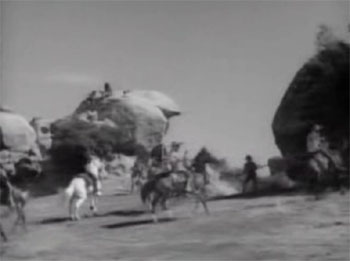
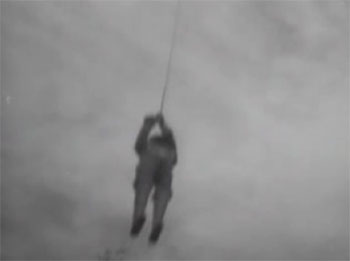
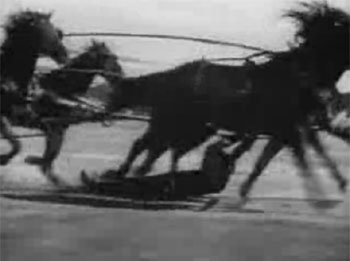
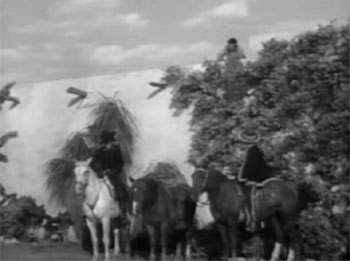
Above: The onset of the first battle between the Legion and the Yaquis (top left), Zorro escaping a landslide by means of his whip (top right), the stagecoach fall (bottom left), and the escape from the fort in Chapter Eleven (bottom right).
The serial almost entirely eschews fistfights in hero-villain encounters, relying on swordfighting sequences instead. This substitution immensely enhances the old-fashioned Spanish atmosphere and effectively sets Fighting Legion apart from most other Republic serials; however, the swordfights themselves vary widely in quality. The one-on-one combats are very well-done, as a rule–thanks largely to the aforementioned Ralph Faulkner and to the basic fencing training that star Reed Hadley received at the suggestion of the directors; the Hadley-Faulkner duel in the first chapter is outstanding. Hadley’s swordfights with multiple opponents are much more uneven; the mine fight in Chapter Three, the armory fight in Chapter Four, and the council-chamber fight in the final chapter are all handled nicely, but other sequences–particularly the cave fight in Chapter Eight–are marred by extremely poor fencing moves on the part of some of the villains (particularly action heavy Jim Pierce), who simply hold their foils above their heads and bang them against Hadley’s rapier, without attempting any thrusts or lunges.
The serial’s chapter endings are consistently imaginative and exciting, featuring some clever variations on standard serial perils to fit the unique milieu–like the windlass-operated elevator that crashes down on Zorro at the end of Chapter Three, or the dike that the villains break down to drown Hadley and William Corson in a tunnel at the end of Chapter Eight. The Chapter Two ending, with Hadley and the wounded Corson trapped inside an old mission that’s about to explode, is especially memorable (and its solution especially spectacular); Hadley’s Chapter Four race to cross a suspension bridge before a wounded Indian can cut it loose is another highlight, as is the attempted bow-and-arrow assassination of Hadley at the end of Chapter Nine.
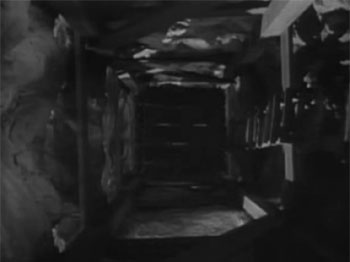

Above: The elevator descending (left) as Zorro climbs up the shaft (right).
Zorro’s Fighting Legion is visually striking even when the heroes aren’t in actual danger; scenes like the midnight assemblies of Zorro’s men at the old mission (an impressive set) or the appearances of Don-Del-Oro in his hellish, fire-pit-lighted cavern temple would do credit to many a feature film. Republic’s big Spanish fort and their hacienda set, seen in many other B-westerns and serials, make a perfect backdrop for other scenes, while Iverson’s Ranch provides the setting for most of the outdoor action.
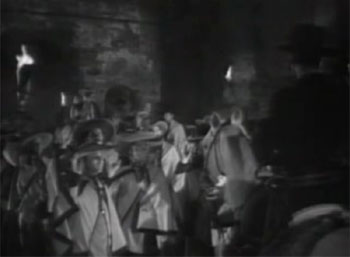

Above left: Zorro (mounted, back to camera) swears in his men at the old mission. Above right: A soon-to-be-executed henchman is brought before Don-Del-Oro (enthroned, back to camera) in the villain’s temple cave.
Both action and non-action scenes are accompanied by a score that ranks as one of the best in any serial; composer William Lava gives the music–particularly the brisk pieces played during the action scenes–a Spanish motif that fits the subject matter perfectly. The serial’s theme song, “We Ride,” is also excellent; while the lyrics are nothing special, the accompanying music makes it a true winner; the sequence in which Zorro assembles the Legion to the backing of the song is particularly rousing. Lava, interestingly enough, would go on to compose the equally strong music of Walt Disney’s Zorro television show in the 1950s.
Reed Hadley’s strong leading performance is another big point in the serial’s favor. He’s imposingly authoritative as Zorro, using his deep, commanding voice and his imposing height to give the character real presence. As Diego, he affects an amusingly timid and lackadaisical manner, but is easily able to snap into shrewdness or suavity as the case requires. Whether acting the fop or the hero, he always comes off as alert and thoughtful; many serial stars could have carried off the action aspects of his role, but few could have been as successful as Hadley was in conveying the extreme intelligence appropriate to the foxy Zorro.
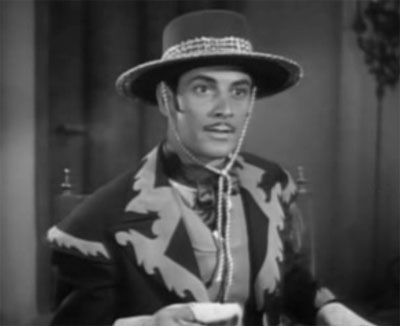
Above: Reed Hadley as Diego, balancing guile and goofiness as he asks some questions.
William Corson, as Diego’s cousin and trusty sidekick Ramon, is likable enough but very bland; his slightly nasal and very American-sounding voice also sounds out-of-place in the serial’s milieu. Sheila Darcy, as Ramon’s beautiful and slightly haughty sister Volita, seems much more at home in her role; she has little to do, but some of her irritated interchanges with Hadley are enjoyable. Budd Buster is good as Diego’s servant Juan, coming across as tough, crafty, and level-headed despite spending most of his time in the background.
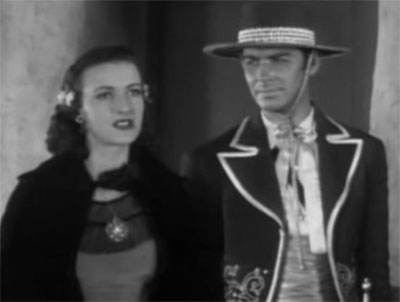
Above: Sheila Darcy and William Corson.
As I’ve already mentioned, the open crookedness of the four principal Council members harms the guessing-game aspects of the serial, but the device does allow each actor in the villainous quartet to be more colorful and more interesting than the usual Republic board of suspects. Edmund Cobb’s blustering and falsely jovial Gonzales, John Merton’s arrogant and aggressive Captain Manuel, Leander De Cordova’s mild-mannered but cunning Felipe, and C. Montague Shaw’s suave and shrewd Pablo are all great fun to watch as they scheme, underhandedly acquire information, or worry about Zorro.
Don-Del-Oro is one of Republic’s best mystery villains, thanks largely to his creepy mask (which really does look like some nightmarish pre-Columbian idol) and his imposing, booming voice (provided by Billy Bletcher). Former screen Tarzan Jim Pierce is physically intimidating as Don-Del-Oro’s lead henchman, although his fencing skills (see above) leave much to be desired and his dialogue delivery is more stolidly tough than nasty. Joe Molina is much more sinister in manner as the Yaqui war-chief Tarmac, while Charles King, Curley Dresden, and (especially) the mean-looking Al Taylor are very good as the other principal members of the henchman pack. Other thug roles are played by members of the stunt team, while Alan Gregg and Ernest Sarracino have minor but notable parts as (respectively) a captured henchman who agrees to turn informer and a disobedient henchman who’s tossed into a fire pit by Don-Del-Oro’s command.
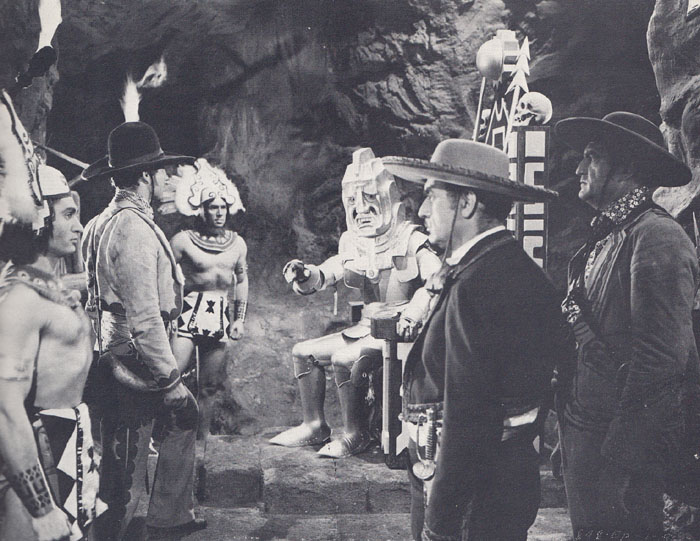
Above: Don-Del-Oro, surrounded by his men (from left to right: Augie Gomez, Al Taylor, Jerry Frank, Curley Dresden, and Jim Pierce).
Paul Marion, usually a shifty henchman, is miscast as the Yaqui prince Kala in the later chapters; someone with a more commanding bearing was needed here. Carleton Young is excellent in his token appearances as the grave and dignified Presidente, although his character (as aforementioned) is temporally misplaced–and also has nothing in common with the ruthless, self-seeking Juarez of actual history. Helen Mitchell is likable as the heroine’s emotional and slightly comical aunt; Guy D’Ennery is also good in his brief turn as the doomed Don Francisco. Jerry Frank is one of Don-Del-Oro’s throne guards, Bud Geary has a bit as a thug, and song-writer Eddie Cherkose (author of “We Ride” lyrics) appears as a guitar-player who serves as the villains’ messenger. The marvelous ham Theodore Lorch is sadly reduced to a background part as a Council member, Jason Robards Sr. pops up as a cantina proprietor, and Clayton Moore can be glimpsed (very briefly) as a member of Zorro’s Legion in Chapter Eleven (he’s one of the volunteers chosen to aid in the rescue of Kala).
Zorro’s Fighting Legion fully deserves its reputation as a serial classic; its few cases of miscasting and its occasionally awkward duelling scenes are rendered utterly insignificant by its leading man, villain, stuntwork, pacing and editing, and terrific production values. It’s a particularly memorable and vivid entry on the long list of serial classics from Republic’s peak period.
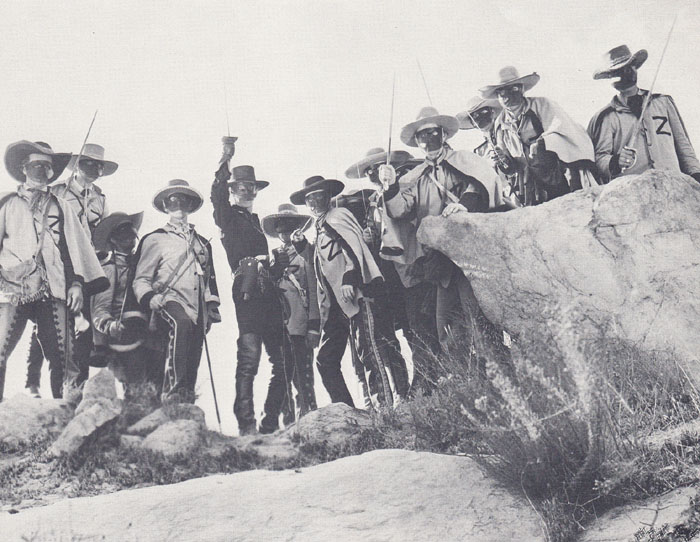
Above: Zorro and his Fighting Legion.
Thanks for this marvelously well-informed and entertaining essay. I first saw this serial on TV more than 50 years ago when I was growing up, and recently purchased it on DVD – primarily to hear the terrific music again. Am looking forward to reading more of these retrospectives.
Jerry,
Most of the guys in the chat room rate Spy Smasher as the best Republic but I say it’s Zorro’s Fighting Legion. Can you find anything wrong with this serial? the answer is no!!!!!!!!!!!! A great story, stars, action and above all the musical score. Reed Hadley is Zorro and a great Don Diego Vega. My favorite Serial !!!!!!!!!!!!!!!!!Bar none
Barcroft
Another Republic peak and a strong contender for the best ever serial.
This is one serial where the phrase “firing on all cylinders” aptly applies. “Zorro’s Fighting Legion” is simply superb! For me, it’s also the best visual interpretation of the Zorro character. The look here- especially with the knee high riding boots and Reed Hadley’s lanky frame- makes this Zorro look like sleek soldier ready for action
Great review, as always, Jerry.
If this is not the best serial ever it has to be
Not only one of the finest serials ever made, one of the finest films to feature the Zorro character.
Charles King shows up in the Cast and Has Sword Fights….I think Charles was in every Serial ever made !!!
One of the all-time greatest, excelling in virtually every department. Despite the historical inaccuracies, it still has an exciting flavor of the period, and makes for a nice change from the usual Western settings. The terrific cast, headlined by Reed Hadley’s wonderful performance, doesn’t disappoint, save for William Corson’s lackluster and decidedly out-of-place casting. A real winner.